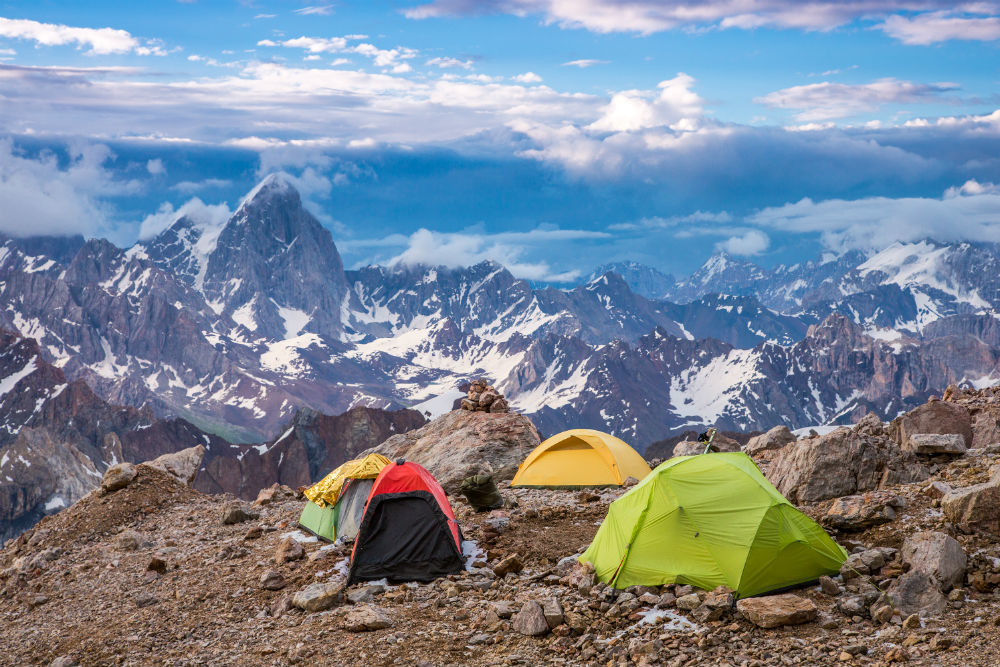How To Maintain Personal Hygiene On A Trek?
January 24 2023 – Nysh Website

As much as it's fun to go on a trek and admire the beauty of nature, it's also extremely difficult to maintain personal hygiene. In the wilderness, you don't have access to personal hygiene products like soap, water, toilet paper, etc. However, it's important that you have alternatives and can take care of such things for yourself. Let's have a look at some tips that will help you maintain personal hygiene on a trek and make the most of your travel experience.
Tips To Maintain Personal Hygiene On A Trek
1. Bathing
2. Oral Hygiene
3. Foot Hygiene
4. Fresh Clothes
5. Food Hygiene
6. Female Hygiene
1. Bathing
On most treks, you won’t have a lot of water to take a bath and get rid of all the dirt from the day’s trek. In cases like these, you can take a sponge bath or a dry bath. Using a damp cloth to clean yourself is the only kind of bath you can expect when you're on a trek. It helps get rid of all the germs and dirt with minimal usage of water.
If you know you're going to have a source of water to take a shower on the trek, make sure you carry disposable toiletries. They get absorbed in the soil and decompose faster compared to the regular ones that you get in the market. Plus, if you prefer a dry bath, you can carry some disposable wet wipes. If you don't have disposable wipes, you’ll have to carry the used ones back to the city and dump them there.
You may also want to ensure that your hair is washed and cleaned on trips. Most times, you won't have the luxury of getting a full hair shower, but you can rinse your hair in water every two days. This ensures that your hair does not get greasy or get damaged. You can also use dry shampoo or baby powder to ensure that your hair is dry and somewhat manageable.
2. Oral Hygiene
Not having enough water is the reality of most treks, and you’ll have to work around that to ensure you're maintaining your basic oral hygiene. This, by default, includes brushing your teeth. You’ll have to work with a dry toothbrush most days when on a trek. That's just how life is for adventure seekers who love to be in the presence of nature. But that's not going to be enough, so you’ll have to make sure you’re extra careful. Rinsing your mouth after every meal will ensure that the food particles don't get accumulated in the gaps in your teeth and gums. These are just some minor things that will need your attention whenever you go on a trek.
3. Foot Hygiene
It's not just bathing and oral hygiene that you need to look out for; something as basic as foot care is also equally important. You're going to be on your feet for the most part of your trek, and you need to care for them as much as you can. You should cut your fingernails and toenails before you leave for the trek. Carrying a nail cutter is going to come in handy on longer-duration treks. You also need to change or remove your socks at least once a day. This gives your feet some breathing space and prevents them from catching bacteria or foul smells.
4. Fresh Clothes
When you're on a trek or a hike, you only have so much space to carry everything you need. Surviving a trek with limited clothing is something you need to manage. While you can change your outer clothing every other day, changing your innerwear on a daily basis is very important. You need to carry a fresh pair of underwear for each day of your trek, as you may not have a chance to wash your underwear quite often.
Change your underwear and/or other essentials once you've cleaned yourself and are done trekking for the day. And don’t forget to pack your used clothes in a separate bag so that they make no contact with your fresh clothes. If you don’t keep your fresh and used clothes separate, it increases the risk of growing bacteria and fungus.
5. Food Hygiene
Maintaining your food's hygiene is going to be important when you're on a trek. Using reusable or easily disposable cutlery is advisable, as you’ll (again) not have water to wash your hands. You don't want bacteria or fungus growing on any of your vessels, food items, or other items that you have in your inventory. Carrying your own cutlery is going to be helpful, as you can keep reusing it every time you're having a meal. Washing and cleaning your cutlery is far easier compared to cleaning your hands.
Cross-contamination between different kinds of foods is quite common. When you're on a trek, washing hands before and after eating is crucial. This way you don't spread germs or bacteria from one thing to another. Keeping dry food items away from meats and vegetables also becomes essential if you want to avoid cross-contamination.
6. Female Hygiene
Trekking while you're on your period can be extremely uncomfortable. But you don't have to worry about it, as there are some tips that will help ease your discomfort. Using a decomposable sanitary pad, pantyliner, or tampon is going to be helpful because you can easily dispose of them in a pit. But the best thing you can use is a menstrual cup. It can help you survive without a restroom for quite some time and doesn't require any disposal. You also need to carry your medication if you need it and stay hydrated throughout the trek. Besides, washing yourself every time you have some water available is going to be the ideal thing to do.
Summing Up
These are some of the basic tips that can help you maintain personal hygiene on a trek. These tips will enable you to take care of your personal hygiene as you normally would if you were back at home. Keeping your well-being in mind, do make sure to follow these tips on your next trekking adventure and make the most of it.
FAQs
How Do Backpackers Wash Their Clothes?
Washing clothes during a trek is not usually feasible as you’re constantly moving and don't have a clean water source at all times. But when you do, using organic soap and rinsing off the clothes with water is the best option.
How do I stay warm in the cold?
Staying warm and comfortable is as important as taking care of your hygiene you can use a number of things to stay warm for example using warm winter clothing, Thermal wear or body and hand warmer it helps in keeping you active and comfortable during the trek.
How Do You Wash While Hiking?
A sponge or dry bath is the best way to wash while hiking. You can use a damp cloth or wet wipes to clean yourself at the end of your day's trek.
How Can I Stay Clean Without A Shower?
You need to change your clothes regularly and take a dry or sponge bath to ensure you’re getting rid of all the dirt on your body. Using deodorant is also going to help you smell fresh.
Why Is Health And Hygiene Important In Hiking?
Personal health and hygiene are very important to take care of when you’re hiking. It just prevents you from getting any infections or diseases in the wilderness.
Should I Shower Before Hiking?
Yes, a pre-trek bath is just as crucial as packing warm clothes for the journey because, when you're on the hike, you’re not going to have the luxury of taking a clean shower every day.


0 comments